
2016 Commencal Supreme DH V4 – Ridden in Andorra
Ooommppphhh. All 220mm of travel compresses, my foot blows off the pedal and one of my testes makes a run for my throat as it connects hard with the saddle. I just cased the hell out of the first road gap on the World Champs downhill course at Vallnord in Andorra. And in front of a crowd. Oh and I am riding a new prototype downhill bike. Awesome.
The rear wheel has taken the brunt of it and the pristine landing lip that has had hundreds of racers fly over it in the past few weeks now sports a good divot from my chain guide biting into it. Somehow I’m still alive and, after a check, I still have two testes where they should be. Four runs in on the new Commencal Supreme DH V4 and this was the scene.

Myriam Nicole (Pom-Pom) on the Supreme DH V4 at the Lourdes World Cup earlier this year. The new bike has been developed closely with the race team. Photo – Commencal/Sam Decout
The trails at Vallnord in Andorra are not for those new to mountain biking, though they are working on that. The terrain is very steep from the top of the gondola back to the village of La Massana, so trying to find an easy grade is nigh on impossible. We warmed up on a trail that Commencal rider Pierre-Edouard Ferry (PEF) designed and built. Fittingly it’s called ‘Commencal’ and it’s very similar to Crank it Up in Whistler’s bike park. Easy rollers, tables and big berms allowed us to get a feel for the new bike before we started to throw them into rougher and considerably steeper terrain.
So what of the bike? Commencal’s designer Nico Menard has dipped into the historical design book a little and produced a frame with a high pivot and an idler pulley. Reminiscent of a Balfa BB9 or Canfield F1 and, more obviously, the V-Process and Sunn bikes that Nico Voulliouz rode to numerous victories a decade ago. Commencal’s owner and namesake Max Commencal was not keen to build this configuration, until he took an early prototype based on a Meta frame for a spin.
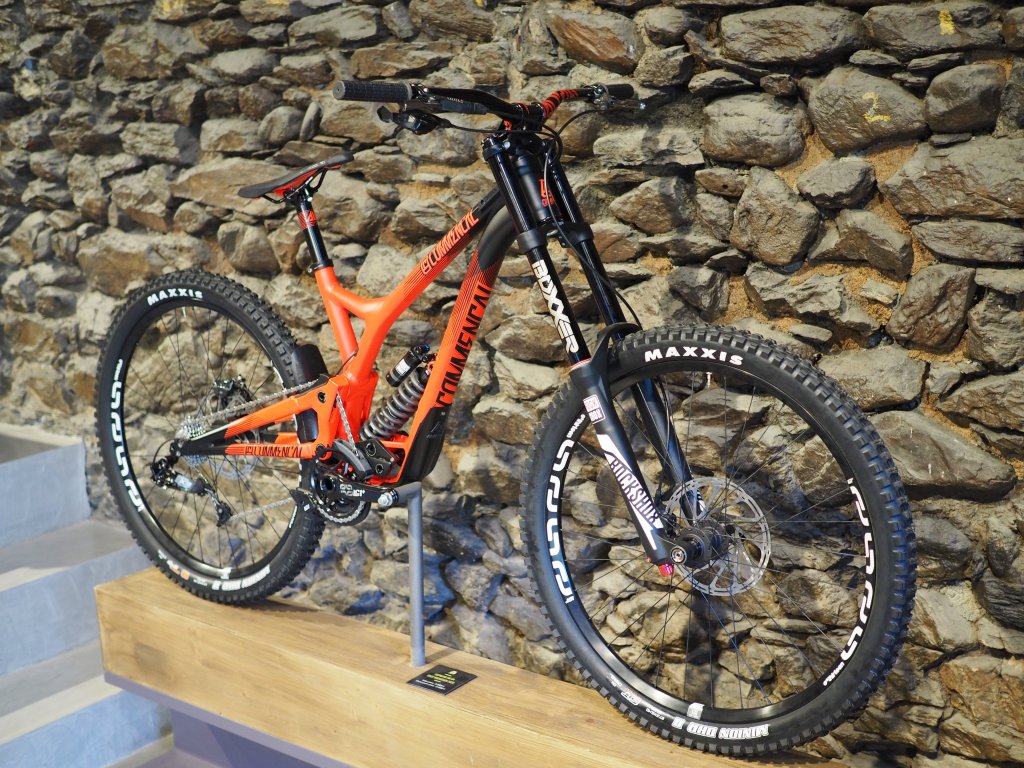
A not quite but very close to production version of the Commencal Supreme DH V4 at the new Commencal HQ in Andorra. This is the Race level build of the bike and will retail for $3,999 USD.
Max’s initial reluctance was due to aesthetics. High pivot bikes, with long chainlines, ugly pulley wheels and awkward lines, are rarely easy on the eyes. A bike may work really well but if it is an ugly beast then punters like us don’t tend to lust over them – and Max wants to sell bikes. He wanted a downhill bike with showroom appeal that didn’t offend his European sense of style. I think he succeeded with the V4. The low stance, with the shock cradled by the bottom bracket, work with the sleek lines of the aluminium frame to communicate speed.
High pivot bikes are lauded for an axle path that moves the rear wheel not only up when it smacks into a bump, but also backwards. This is the ‘square-edged hit performance’ that we often hear about. Giving the back wheel the ability to move up to the point where it can crest a bump without trying to drag the wheel through that bump stops the wheel hanging up. That in turn reduces the amount of speed that said bump can suck away from you, helping the bike maintain momentum through the meatiest of rooty sections. It also comes into play when you are loading up on G’s in a turn as the wheel base of the bike lengthens, adding to the stability of the bike.
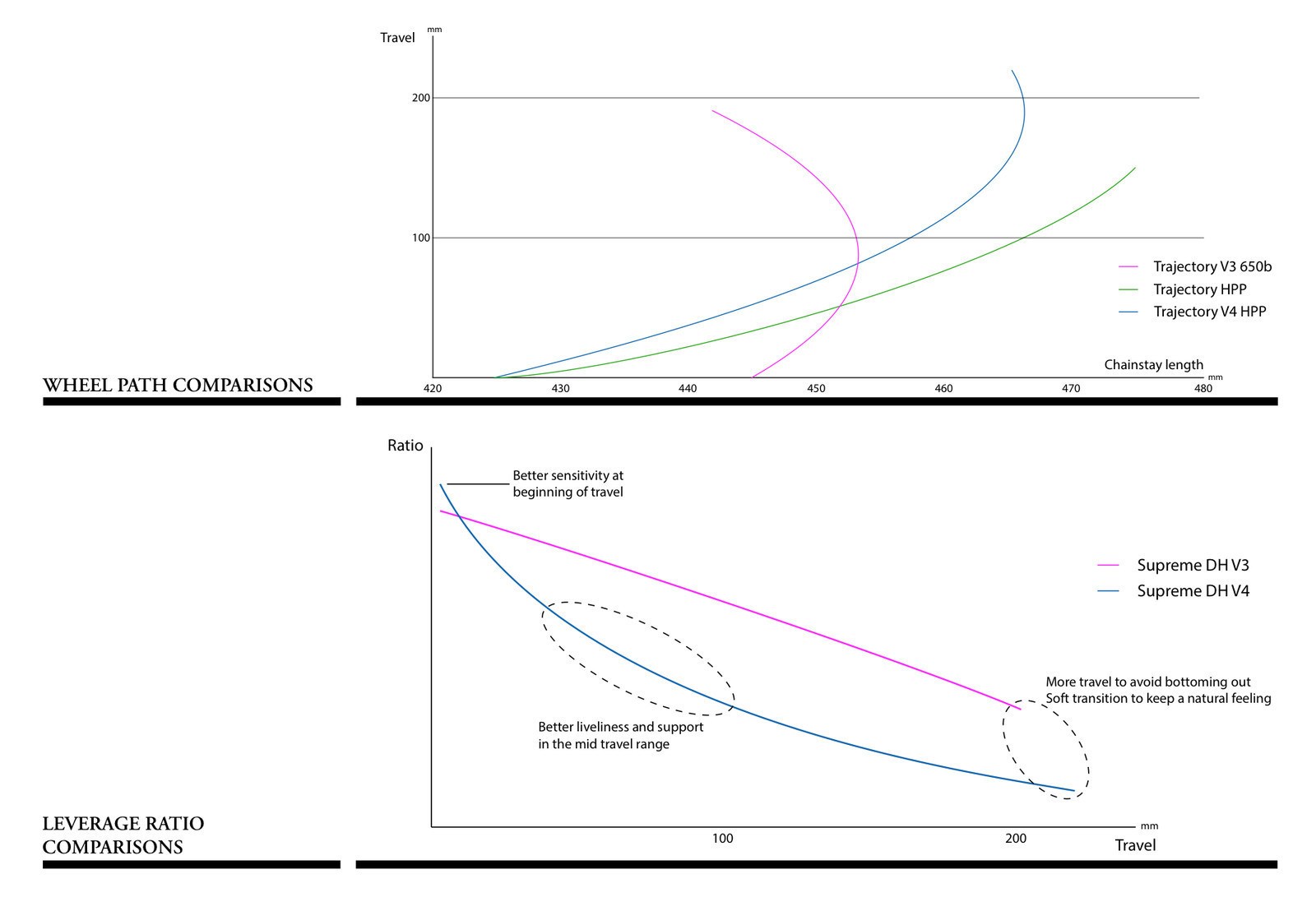
For the suspension geeks out there – some charts that show the chainstay growth of the new V4 verses the V3 along with leverage ratio comparisons.
The swing arm compresses the 267mm stroke shock with two swing links, sat low on the frame. These stiff links isolate the shock from any side loads that the swing arm may be experiencing but also allow for the tuning of the shock rate through the stroke. This builds in a rising rate from the start of stroke to the sag point, and then makes the stroke more linear from there on. The desired effect is to achieve suppleness to start and then a bottomless feel without a harsh bottom to the stroke. I can attest to not feeling the shock bottom out when I cased the ball-crushing road gap.

A better view of the linkage that actuates the rear shock. The high pivot is a little lower than the first test mules the Commencal crew were playing with.
The interesting thing with idler pulley bikes is that a lot of them tend to place the axle of the pulley in the same plane as the pivot. While this will give you rear suspension completely unaffected by chain tension, it wasn’t the solution that designer Nico Mennard fell upon with the V4. When your sponsored riders are in a position to be putting in some pedal strokes on a track the terrain is typically smoother. This means that the suspension can take a certain amount of pedal induced stiffening and will give the bike a more responsive feel. The idler pulley axle sits slightly lower than the main pivot which will slightly firm the suspension when laying down some watts, while providing some feedback through the pedals from the rear suspension.
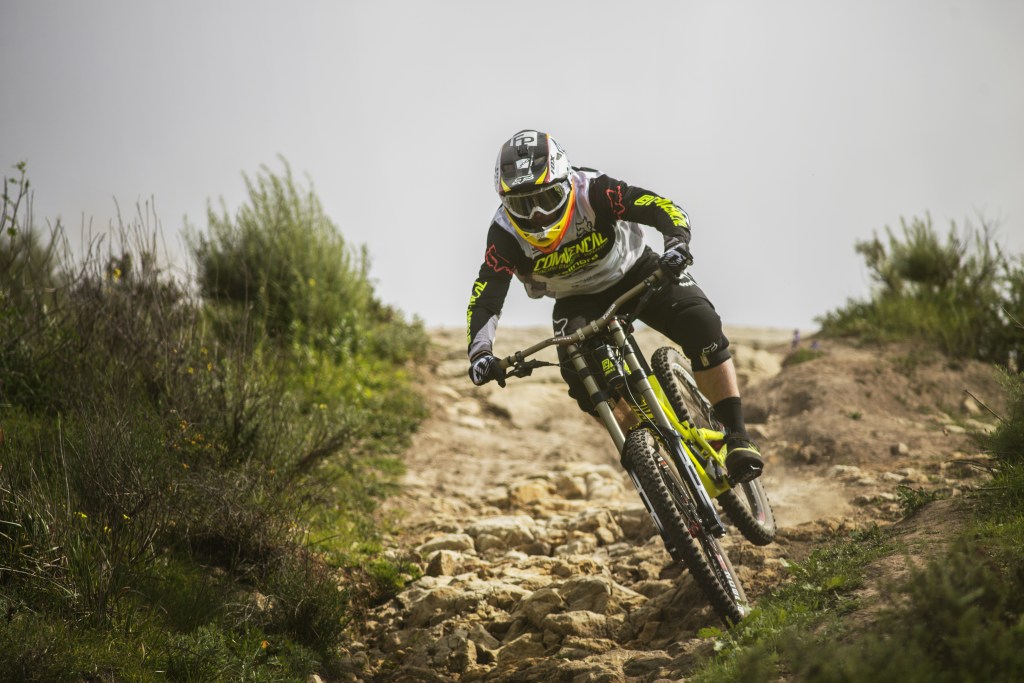
Remi Thirion on the prototype Supreme DH V4 in California before the race season started. Remi did back to back testing with the V3 against the clock and was surprised at the extra speed he was able to carry. Photo – Commencal/Sam Decout
This effect can be tuned further by changing the size of that pulley. Currently sat at 16 teeth, Nico is toying with offering a 15 and 17 tooth pulley that would increase and decrease the pedal feedback respectively, tweaking how the rear suspension stiffens under power by changing that chain line slightly. That tweak might be lost on us mortals but in World Cup racing marginal changes like this can take a racer from a top 10 to a podium.
Noise can be the bane of idler pulley bikes. Clutch derailleurs help with that now, but with the chain running so close to the swing arm on its run from the rear cassette up to the pulley, the chain can easily touch the frame. To prevent this, the V4 will come with integrated protection to dampen any dings. Even without the production version of the protection the V4 is a silent assassin and there is little in the way of whirring from the pulley when pedaling along. Because that aluminum pulley takes a lot of load when you are on the gas, a large diameter cartridge bearing handles the RPM. Commencal used their racers’ wattage outputs to test the longevity of the pulley and its bearing this past season.

That chain line… up and over a pulley sat just below the upper pivot and down to the chain ring. Production frames will come with molded on rubber protection along the chain stay to keep drive train noise to a minimum.
One of the subtler points of the frame progression from the V3 is that the rear end of the V4 is actually less stiff than its predecessor. In the realm of beefy downhill rigs, particularly those made from carbon, the rear triangle does look particularly slim as it flows to the bolt-on rear dropouts. It’s not often that you hear that in the bike industry, with metrics of improvements in such things as stiffness often thrown around to make us think that things are improved.
Commencal tells us the flex was carefully tuned to allow the rear end of the bike to track the ground effectively and give levels of grip that open up line choices. Combined with the kinematics of the rear suspension, suppleness to the point of sag, it endows the V4 with the ability to pick a rooty high off-camber line and blow your mind that you have just ridden it without deflecting down the gradient. There is a lot of that on what we rode in Andorra so I’m speaking from experience.

The rear end of the Commencal Supreme DH V4 looks pretty slim compared to many other DH bikes and suprisingly is not as stiff as the rear end of the V3. This is on purpose and the flex has been built in to give the bike better grip through rough sections of trail.
Geometry wise the V4 is pretty conservative out of the box. The prototype frame that I was on had a 62.5 degree head angle that will be steepened to 63 degrees for production. If that doesn’t sit well with you then the full 1.5” head tube will allow for offset cups to be installed to not only adjust head angle but also tweak the reach by 20mm. That is a full frame size in reach adjustment. Bottom bracket height has gone up slightly from the V3 to account for the slightly longer travel and the rear stay sits at 425mm statically. Obviously, for a bike with such a high pivot once the bike is loaded with my 185lbs, the chain stay grows.
We rode some legit steep terrain that was loose dirt and loam mixed with the shaley rock that makes up the local geology. Throw in a good dose of roots and the odd rock slab and you have some terrain that doesn’t differ too much from my home turf. You absolutely had to have confidence in your hardware on this terrain because there’s no room for error. Many of you will have seen the footage from the World Champs and that track is steeper than it looks at the bottom. I was able to ride it but racing that at the speed we witnessed over the live feed is something hard to comprehend. I was just trying to keep the bike upright. Even the top section is no joke with roots just littered all over and some insane looking line options for those with the skill.

Remi getting deep into a turn on the new Supreme DH V4. The chain stays lengthen when the bike is loaded into a turn giving the bike more stability. Photo – Commencal/Sam Decout
I will now admit that I don’t spend a load of time on DH bikes. A 6″ travel bike provides most of my fun these days. I don’t think that this is a bad point to approach a mini review of a downhill bike from. I’m used to a bike that reacts to the terrain and doesn’t over cushion the experience. A DH bike lets me rally harder on rough terrain so that I’m going faster by the time I fear for my life
The V4 is a bike that can be enjoyed by mortals like me and also ridden so wildly and effectively by Rémi Thirion. It doesn’t overwhelm by being so long and slack that you have to ride it like your hair is on fire to get the most of it. Even on our warm up laps the bike felt fun to pop off the rollers and gap into the transition of the next. The head angle suits the reach of the bike well, so excessive shifts in body weight aren’t needed to load the front tire into a corner.
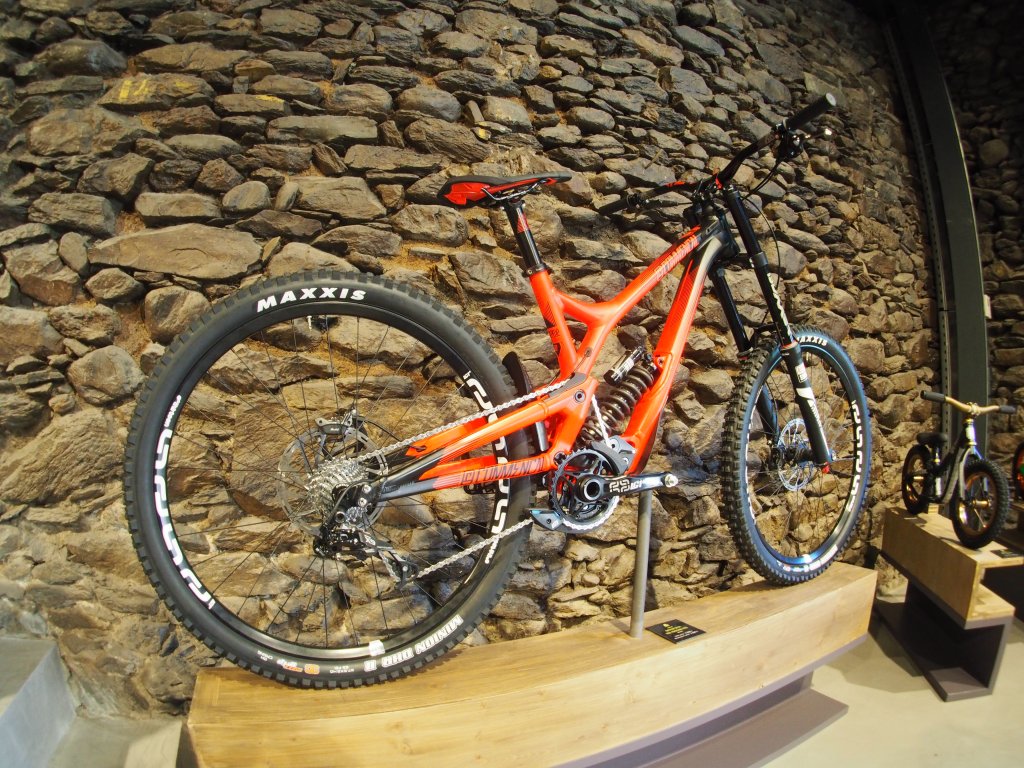
The Commencal Supreme DH V4 is blessed with sleek lines, helped by the shock being placed low in the frame. This helps with keeping the weight of the bike lower but also gives the bike good stand over height.
Of course with 220mm (8.7″) of travel this bike gobbles up terrain but does so without wallowing. The rear axle path contributed to the involuntarily giggles emitted as the bike pummelled through chunder without loosing speed. The DH V4 is designed to operate in the first 200mm of travel for most of the hits you will encounter. The final 20mm of travel has a more aggressive spring rate which means only the biggest (plum crushing) hits will see you get that deep into the travel.
Long travel and supple suspension at the beginning of the stroke don’t shout responsive, but the V4 has a very well balanced suspension feel that responds well to rider input. You feel in command of the bike and able to place the wheels onto the line you choose without fearing the bike won’t respond to your input in time. There’s a distinct feel that may benefit those of us who don’t always ride clipped in. On the roughest sections of the tracks we rode, I never felt like my feet would blow off the pedals. The chain line isolates the pedals from the hits but not to the point that you don’t appreciate what the V4 has just plowed through.
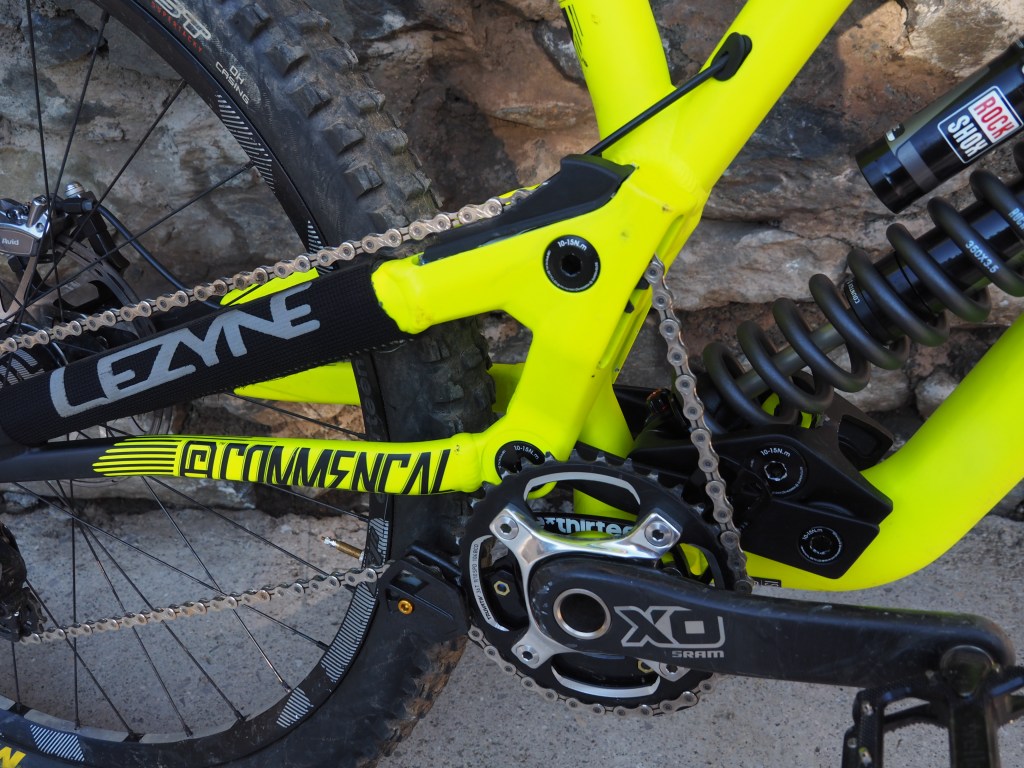
The upper pulley is hidden and integrated into the rear triangle. The pulley sits slightly below the pivot for the rear triangle, which will slightly stiffen the rear suspension when the chain is under tension.
On the brakes the bike will want to squat into its travel, adding stability as you initiate a turn. That squat isn’t so excessive that the rear wheel skips around on the bumps and you are still able to slam on the anchors late and pitch the bike in. A floating brake caliper was an option to start with but, after testing, the racers and test riders didn’t feel like it was needed.
The bike begins to shine when you start to find the limits of grip through rough terrain, especially on off-camber sections. The high lines you can pick are shocking. I kept expecting to be knocked lower but the bike held the line. This is a great card to have up your sleeve when things don’t go as planned.
All in all an impressive first ride experience on a bike that already has a good pedigree. The icing on the cake for Commencal would have been some rainbow stripes but it wasn’t to be. Still for the weekend hacks like you and I, this Commencal has a lot to offer. A solid feeling frame that will be competitively priced. The frame alone will retail for $1,699 USD and complete bikes start at $2,999 USD for the Origin build and go up to $5,699 for the World Cup build (which comes with Rock Shox front and rear). The Race level build that I rode will retail for $3,999 USD which has Rock Shox front and rear and E13 wheels and cranks. That seems like very competitive pricing to me.
Commencal already has an office in the US and will soon open an office and warehouse on Canadian soil so they are really making sure that they have their support networks in place for their customers on both sides of the Atlantic.
Bringing back memories of your Balfa?







Comments
t.odd
8 years, 7 months ago
ahem….BB7
Long live Balfa!!
Reply
RepublicMalcolmIsland
8 years, 7 months ago
Boast 148 is the mountain bike version of an above ground backyard swimming pool, and trek is the MTB manufacturing version of Black Lives Matter.
I am pretty sure in 30 years from now, some guy will be digging around in the New Mexico desert. Looking for the dreaded hubs, that almost ruined an entire industry.
MTB better take a good long hard look at what the videogame industry did to itself, in the early 80s. Valuable lessons to be learned there. Both in how to fail, and rise back up from the ashes.
If E.T. for Atari can eventually progress into Fallout 4; I feel things in my spine, when I think to what the future holds for MTB.
Reply
Nat Brown
8 years, 7 months ago
I don't see boost anywhere in the article, but don't let that stop you. This isn't Pinkbike.
You did pique my interest with your Trek-BlackLivesMatter analogy. Would you please elaborate on that, because I don't understand your point.
Reply
Joe G
8 years, 7 months ago
good practice in journalism - and in life: never show a graph with a blank axis (the leverage rate has no labeled or scale to the Y axis)
Reply
Jonathan Harris
8 years, 7 months ago
The graph came from Commencal like that and probably for good reason. Not wanting to give the game away to much me thinks.
Reply
Joe G
8 years, 7 months ago
without a sense of scale (the lower and upper limits of the Y scale displayed) it may also be misleading. What "good reason" would there be to leave it off? If the information is secret, don't give it out. If the information is factual, display the data. The scale will show whether the change from old to new is drastic (as displayed) or subtle.
Reply
Callum Bland
8 years, 7 months ago
You spelt things as tings in one of your paragraphs. I like tings like this, it gives the review a more relaxed feel.
Reply
Derp
8 years, 7 months ago
spelt?
Reply
RepublicMalcolmIsland
8 years, 7 months ago
Relax, bruh.
Reply
Nat Brown
8 years, 7 months ago
Boo.
Reply
Please log in to leave a comment.